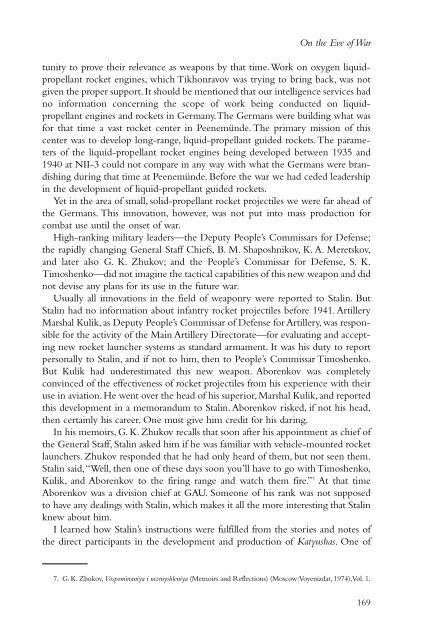to open next chapter. - NASA's History Office
to open next chapter. - NASA's History Office
to open next chapter. - NASA's History Office
Create successful ePaper yourself
Turn your PDF publications into a flip-book with our unique Google optimized e-Paper software.
On the Eve of War<br />
tunity <strong>to</strong> prove their relevance as weapons by that time.Work on oxygen liquidpropellant<br />
rocket engines, which Tikhonravov was trying <strong>to</strong> bring back, was not<br />
given the proper support. It should be mentioned that our intelligence services had<br />
no information concerning the scope of work being conducted on liquidpropellant<br />
engines and rockets in Germany.The Germans were building what was<br />
for that time a vast rocket center in Peenemünde. The primary mission of this<br />
center was <strong>to</strong> develop long-range, liquid-propellant guided rockets.The parameters<br />
of the liquid-propellant rocket engines being developed between 1935 and<br />
1940 at NII-3 could not compare in any way with what the Germans were brandishing<br />
during that time at Peenemünde. Before the war we had ceded leadership<br />
in the development of liquid-propellant guided rockets.<br />
Yet in the area of small, solid-propellant rocket projectiles we were far ahead of<br />
the Germans. This innovation, however, was not put in<strong>to</strong> mass production for<br />
combat use until the onset of war.<br />
High-ranking military leaders—the Deputy People’s Commissars for Defense;<br />
the rapidly changing General Staff Chiefs, B. M. Shaposhnikov, K. A. Meretskov,<br />
and later also G. K. Zhukov; and the People’s Commissar for Defense, S. K.<br />
Timoshenko—did not imagine the tactical capabilities of this new weapon and did<br />
not devise any plans for its use in the future war.<br />
Usually all innovations in the field of weaponry were reported <strong>to</strong> Stalin. But<br />
Stalin had no information about infantry rocket projectiles before 1941. Artillery<br />
Marshal Kulik, as Deputy People’s Commissar of Defense for Artillery, was responsible<br />
for the activity of the Main Artillery Direc<strong>to</strong>rate—for evaluating and accepting<br />
new rocket launcher systems as standard armament. It was his duty <strong>to</strong> report<br />
personally <strong>to</strong> Stalin, and if not <strong>to</strong> him, then <strong>to</strong> People’s Commissar Timoshenko.<br />
But Kulik had underestimated this new weapon. Aborenkov was completely<br />
convinced of the effectiveness of rocket projectiles from his experience with their<br />
use in aviation. He went over the head of his superior, Marshal Kulik, and reported<br />
this development in a memorandum <strong>to</strong> Stalin. Aborenkov risked, if not his head,<br />
then certainly his career. One must give him credit for his daring.<br />
In his memoirs, G. K. Zhukov recalls that soon after his appointment as chief of<br />
the General Staff, Stalin asked him if he was familiar with vehicle-mounted rocket<br />
launchers. Zhukov responded that he had only heard of them, but not seen them.<br />
Stalin said,“Well, then one of these days soon you’ll have <strong>to</strong> go with Timoshenko,<br />
Kulik, and Aborenkov <strong>to</strong> the firing range and watch them fire.” 7 At that time<br />
Aborenkov was a division chief at GAU. Someone of his rank was not supposed<br />
<strong>to</strong> have any dealings with Stalin, which makes it all the more interesting that Stalin<br />
knew about him.<br />
I learned how Stalin’s instructions were fulfilled from the s<strong>to</strong>ries and notes of<br />
the direct participants in the development and production of Katyushas. One of<br />
7. G. K. Zhukov, Vospominaniya i razmyshleniya (Memoirs and Reflections) (Moscow:Voyenizdat, 1974),Vol. 1.<br />
169
















